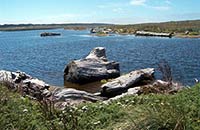Bringing information you can use for action about herbicides, pesticides and other toxic chemicals in northern California and around our shared world
Welcome!
CATs at Work
Our Shared World
Online Store
Programs
Defying Court Ruling, State Parks Aims Hazardous Sprays At Coastal Wildlands

Despite being trounced by CATs in the Court of Appeal for a similar project, the California Department of Parks and Recreation (CDPR) is trying to slip another terrible herbicide spray plan past the public— adding to the mounting evidence that the agency considers itself above state law.
Avoiding a full environmental analysis, the state agency plans to kill invasive plants with broad-spectrum, non-selective herbicides at two Del Norte County sites: the sensitive dune ecosystem at Tolowa Dunes State Park and the Fish & Game-managed wetlands of the Lake Earl Wildlife Area.
Only months ago, CDPR lost in court to CATs for similarly failing to do a thorough examination of its plans to spray the invasive purple loosestrife weed along the Eel River. These plans are on a growing list of CDPR projects undertaken without adequate analysis and public notice.
- Incessant Spraying -
Its current proposal at Tolowa Dunes includes the use of two herbicides, imazapyr—also proposed on the Eel River--and glyphosate.
Imazapyr remains toxic and mobile in soil for up to a year and a half; repeat applications are likely to compound this toxicity. Glyphosate adversely alters soil ecosystems and recently has been linked to reproductive damage in mammals. But CDPR wants to do multiple spray applications to 323 acres for a minimum of three years--and up to an undetermined length of time.
CATs believes the Tolowa Dunes project is in violation of the California Environmental Quality Act (CEQA) because it fails to analyze how the toxic herbicides could affect the 61 special status plants and the 37 special status animals there, along with soil organisms and wetland water quality (see CATs’ critique of the Tolowa Negative Declaration).
In an apparent surreptitious move, the spray plan was issued as part of a Mitigated Negative Declaration in mid-September for public comment, but was never posted on the CDPR webpage. CATs was not notified as an interested party.
While the lack of transparency is disturbing, it came as no surprise considering CDPR’s track record statewide — which includes a rise in the use of Notice of Exemptions, Negative Declarations and Mitigated Negative Declarations in place of full environmental analysis and complete public participation.
- Why Use Killer Chemicals? -
It was such tactics that prompted the Court of Appeal to rule in favor of CATs and its assertion that CDPR failed to do adequate environmental analysis for the purple loosestrife project on the Eel. There, just as at Tolowa Dunes, CDPR planned to spray the invasive plant with imazapyr as the primary treatment without adequate consideration of non-chemical, environmentally appropriate alternatives.
Learning of CATs’ Purple loosestrife lawsuit, people throughout California have contacted CATs about similar projects revealing an apparent pattern of the state agency’s abuse of CEQA.
Examples include a Notice of Exemption in Mendocino County that allowed a bluff overlooking the ocean in Jug Handle State Park to be scraped down to bare soil and then sprayed to remove gorse and broom. Such scorched-earth practices also threaten Southern California parks, such as the removal of 100-year-old orange and lemon groves at Citrus State Historic Park so the soil could be graded and fumigated with an extremely toxic pesticide.
Neither of these activities was posted on the CEQA clearinghouse website for the public or environmental organizations to review because each was deemed non-significant by CDPR.
Though CDPR may claim to use herbicides sparingly, these projects highlight the agency’s chemical habit and likelihood to jump on the herbicide treadmill for invasive weed management in other state parks.
CATs will remain diligent in its mission to watchdog the activities of government agencies and bring information about projects that include pesticide use to its members and the public.
- What You Can Do -
--Familiarize yourself with the CEQA process (http://www.ceres.ca.gov/ceqa/more/faq.html)
--Visit the California Clearinghouse to find proposed projects in parks near you (http://www.opr.ca.gov/index.php?a=sch/sch.html)
--see CATs' analysis of the Tolowa Negative Declaration (212 kb pdf file)
--Go to the State Parks website (http://www.parks.ca.gov/) or visit your local headquarters and ask about management practices that include pesticides. It's public information.
(* photo by Fran Gatti)





